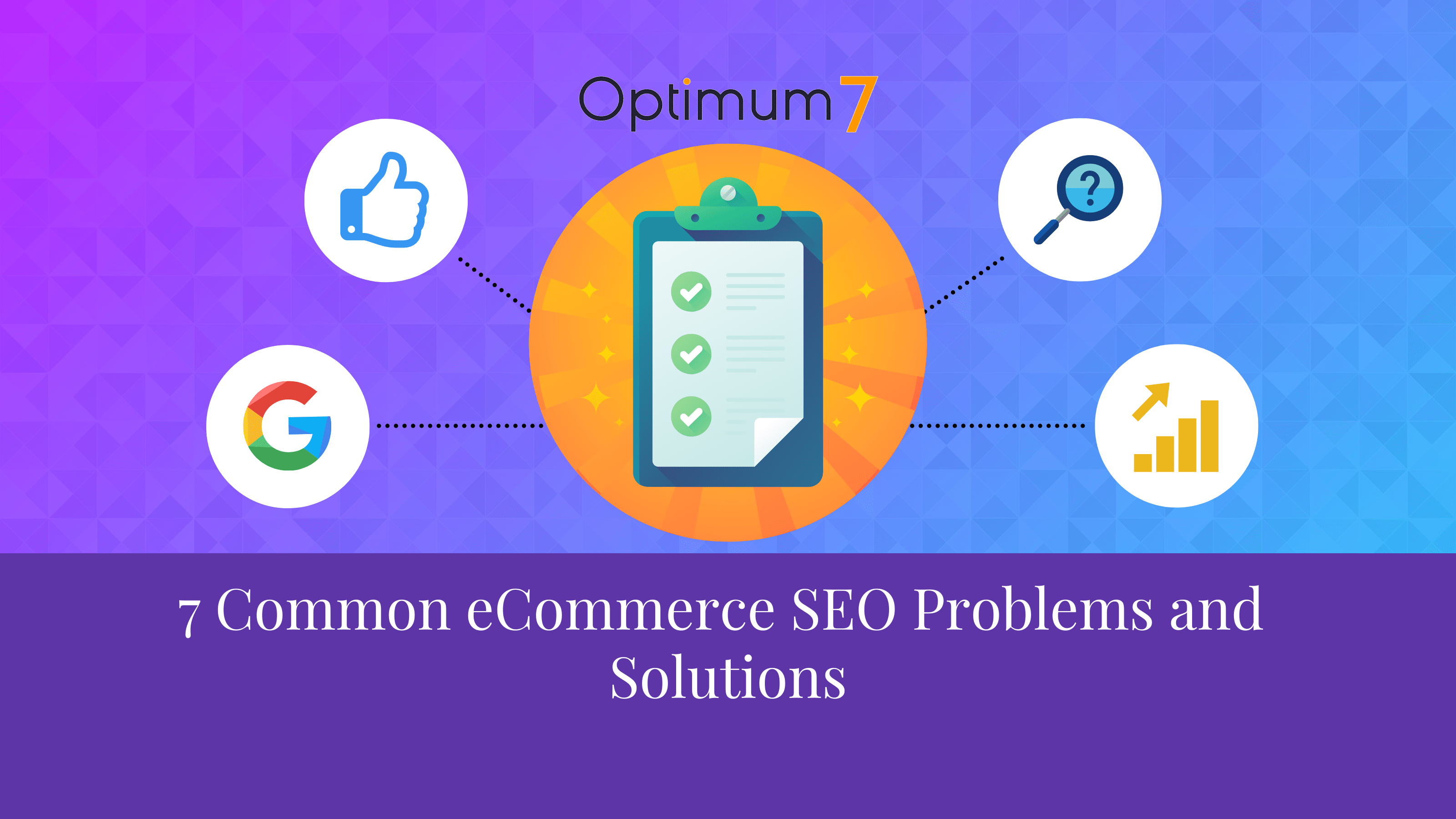Have you implemented a search engine optimization (SEO) strategy for your eCommerce website, but it doesn’t seem to be working? Luckily, these common mistakes will help you identify and solve that eCommerce SEO problem so that you can enjoy higher rankings.
Identifying and addressing common SEO problems for eCommerce sites is essential if you want to improve your shop’s ranking to drive more sales and revenue. In this post, we’ll go over some of the most popular issues that can be found in online stores.
Whether it be a lack of original content with high-quality information, an absence of internal linking strategy, or having two domains each pointing at different product pages, we’ll help you get to the root of it.

1. Poor Migration Between eCommerce Platforms
When you’re running an eCommerce site, it is important to make radical calls when you outgrow your current eCommerce platform. One way of doing this would be by switching platforms when necessary.
Third-party platforms are a great way for eCommerce businesses to focus less on web development and more of their time running the business. However, switching from one platform to another without professional help can seriously hurt your search rankings.
Optimum7 makes sure that your migration process will be as easy as baking a pie. We can make sure that you don’t lose any clients because we have done over 500 migrations between systems. We can suggest you the best platform based on your business and operational needs, so if you can’t figure out which platform is best for you, don’t hesitate to contact us. You can also learn more here.

2. Lack of User Reviews
User reviews are the backbone of any successful eCommerce website. 80% of users say that product reviews influenced their purchasing decisions, and mobile searches for these types have grown by 35%, making it crucial to include them when building your company page so you can rank higher in search engine results pages (SERPs). Otherwise, you’re missing out on 70 percent of your target audience!
Luckily product reviews solve this problem by letting people talk about their experiences on products so others know what they’re getting themselves into before buying them. Additionally, they provide an editor-style perspective that allows more detailed feedback than just one person’s opinion alone could provide.
Moreover, review pages rank higher in search results than selling pages which makes them even more likely to appear first when someone types “product” into search engines. The beautiful thing about product reviews from customers is that user reviews are a great way to create unique content for your online store, but if you don’t have any users or customers who have bought from you in the past then it can be hard!
Therefore, you could ask customers after making purchases or request feedback on social media channels like Facebook & Twitter – just make sure it’s something they will enjoy doing!
Google Wants to See Reviews Too
Your business will benefit from having more reviews because Google likes to see them. They show that a company has been around long enough for people to have used their service/product and provide an indication of how good or bad it was at doing what was promised.

3. Bad Product Descriptions and Unoptimized Product Pages
The most important thing you can do for your product is to give it a good description. Most eCommerce sites don’t do this and that’s why they lose. Make sure that the text on each page of this website represents what’s inside and how people will benefit from reading them; without a quality copy, there won’t be any progress in organic rankings!
Without quality product descriptions and useful, crawl-able copy your products will never rank in the top 10. It is absolutely crucial for your online store that you write quality product descriptions and avoid duplicate content. You can outsource this to a copywriter for pennies on the dollar compared to how much you would be making from organic search visits after the descriptions are in place.
Shoppers love actionable content. They want to know the reasons why they should buy a product, where it comes from, and how it’s made. However, in order to get indexed by search engines (which means higher rankings on search engine results than before), you don’t just need information. You must also provide value so that people will come back for more after reading your post or clicking through on an ad link.
Be Mindful of Duplicate Content
Remember that duplicate content gets punished. It will only hurt your rankings in search results, as Google will flag you for duplicate pages. Repeating content makes your site look spammy, which is a red flag to customers and search engines.

4. Your Page is Not Mobile-Friendly
If you don’t plan for mobile users in your SEO strategy, then this could be one of the reasons why it’s not working as well.
One of the most common problems in SEO for eCommerce websites is that they don’t have a mobile-friendly website. When more than 76% of consumers shop on their smartphones, you must make sure your site ranks higher in SERP with an optimized design and content to keep up with consumer demand.

Speed Optimization
Mobile users want to access information quickly. To make sure your website works for both mobile devices and desktop computers, you need a page load speed that doesn’t delay or block their experience.
Use the Google Page Speed Insights tool, which will show how much improvement can be made by optimizing certain aspects. These might include the compression ratio images, or adding resources like CSS templates into HTML code rather than referencing them externally.
These kinds of changes add significant value towards improving customer satisfaction while also boosting conversion rates as people don’t get frustrated waiting around.
Responsive Design
A responsive design enables your website and content to be seen by as many people as possible, regardless of the device that they’re using. By implementing a responsive eCommerce website you can ensure that all visitors will see what is on the screen correctly, no matter their platform!
Alternatively, not having a responsive design will result in a poor user experience and will kill your organic search traffic. Remember, a poor user experience is a nightmare for eCommerce sites since you won’t be getting any loyal customers.

5. Lack of Crucial Technical Elements
The first thing you should do when creating web pages is to make sure that they have an easy-to-follow URL. You can do this by using all lowercase letters, dashes instead of underscores, and avoiding dynamic parameters as much as possible. Your home page shouldn’t redirect from the root.
Every other link on your website should stem back here so that Google knows exactly how far down each one goes without having any gaps between them, which can cause confusion while also making SEO more difficult than necessary.
When you set up your website, make sure to use a clean and simple design that is in accordance with the latest trends. This will give visitors a pleasing experience from the beginning, and up until their trip ends. Furthermore, they won’t be distracted by excess fluff or noise such as advertising banners, which get annoying.

6. Lack of a Blog and Internal Linking in Your eCommerce Website
A killer way to improve your search engine traffic is by creating product-focused content! What can’t you get with a good description?
Use that as blog post material, create buyer guides, and write evergreen articles around products the users don’t even buy from you. Product upkeep posts are perfect examples of this kind of thing too: they spotlight new features while reminding regular customers of older ones and all their favorite things about buying at your store.
7. Non-original titles and headings
Many online retailers don’t put much thought into a title tag and a header tag. If you’re not sure what these things mean, then the quality of your eCommerce SEO strategy could suffer, because search engines won’t know how to find pages with relevant information about them!
Luckily, we have an easy solution for this problem. Choose great titles or headers that contain keywords to inform both readers and search engines of what your page is about.
Duplicate title tags are a red flag for Google and can be a factor that leads to your eCommerce SEO score dropping. No two products are exactly alike, so even similar products should have differing title tags.
Now you know what might be the issue for your eCommerce store.
The world of eCommerce is a competitive one, and success often rests on how you rank in search engines like Google. To get there, though, it’s important not only that your store has an SEO plan, but that it also follows what your customers are looking for so as to ensure your store ranks well with those words too!
Optimum7 is an award-winning SEO agency, we help thousands of eCommerce business owners get better results. SEO and eCommerce Platform migration is our strong suit. You are more than welcome to contact us.





